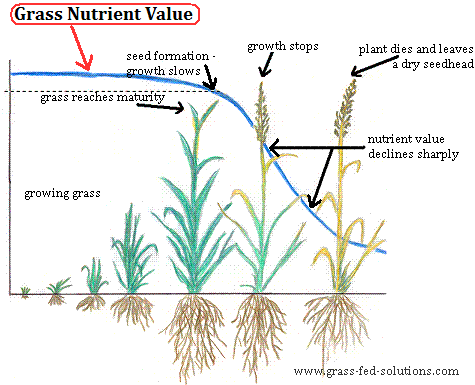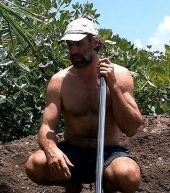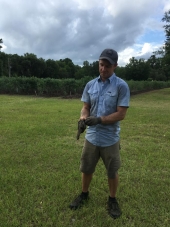Me again!
So, are you sad that you didn't get to go to the
Permaculture Voices conference? Did you go but you can't remember what was said? Well, I am an obsessive note taker (most of the time) and I took notes at most of the talks I attended.
I will share them here with you!
Please note that this is in no way a transcription. These are my notes, taken in real time, on the fly, whilst trying to look at the slides and follow along. I find that note taking helps me synthesize information. None of this should be construed as an accurate quotation, even when I put it in quotes. (For example, I'm pretty sure not a single speaker used the utterance "Yo.") Much of the time, I am trying to summarize and it's entirely possible that I've gotten some things wrong.
My next notes document is Alan Savory. The topic this time was "The role of livestock in a new agriculture that can save city-based civilization"
---------------------------------
Alan Savory
We are all here because we care. Your importance in this room is way beyond your numbers. We are headed for a perfect storm of population growth, desertification and climate change.
We heard for years that desertification was due to livestock. Now we’re told it’s due to climate change.
Man made desertification is a symptom of biodiversity loss. However, we are so compartmentalized it seems impossible to address this massive issue
Our lever for change is on the biodiversity front. I loved Mark Shepard’s talk today, appealing to you permaculturalists to get to work and get your work to scale. People like James Lovelock are saying things like “it’s already too late and 80% of the world’s population will be lost.”
I disagree with him, he is not aware of the latest information. He doesn’t know that desertification isn't due to overuse, it’s due to underuse. He doesn’t see that all management needs to be holistic.
Pic: you can see from space where the desertification is happening. It’s an enormous portion of the world. These are the places with variable rainfall. Not necessarily particularly dry, but places with periods of no rain. Seasonal precipitation.
Desertification happens when biodiversity is lost.
Pic: I took this picture in Yemen when the rain was falling. It was a hell of a lot of water. The next day, all the water was gone. Some soaked in, but even that water left the next day via evaporation.
We want the water to be trapped, to be infiltrated, to move through living soil.
When I left university at age 20, I wanted to save wildlife, and everybody knew that the degradation was due to livestock. When we created national parks and removed the people and livestock, the degradation just got worse. I decided that the problem was too many elephants and we shot 40,000 elephants. And the degradation got even worse.
I came to America, where you guys were supposed to have everything figured out. Pic: horrible erosion and wasteland in a national park. You didn’t. Luckily there were lots of pictures of American rangeland and you can see the degradation from grassland to brush. In a paper on climate change, this was attributed to “unknown causes.”
Here is land I’ve managed for a long time in Africa, with full growth of tall grasses. All this material needs to decompose. If you leave the grass alone, it can’t break down. (pic of oxidized dead grass—it’s gray) Traditionally humans would use fire to remove this biomass. It does work, a little bit. You get a bit of a green flush. However, if you go out in the rain, you can see the erosion happening.
OK, fires won’t work. Technology is not going to replace biological decay of this material. Resting the land just aggravates the problem in dry places. Planting trees and grass has never successfully reversed desertification (ed: Geoff might beg to differ on this).
What works? Look to the book of nature. This is where there were herds of millions of grazers. (pic of wildebeest and zebra). Where you have the massive herds, you have the pack hunting predators. This encourages tight and large herds. This behavior leads to trampled grass, covered with dung and urine. This gets the herd to move on.
It’s not about the numbers of animals, it’s about the time that they spend on the land.
After a heavy group of grazers comes through, the tall grasses are all trampled flat, mulching the ground. When the rain returns, the grasses can regrow up through this mulch.
I came up with a scale of brittleness of climates. It’s a good term, because in a more brittle climate, the leaves are really crunchy and break into tiny pieces at the end of the dry season.
More brittle means large herbivores, pack predators, slow breakdown of matter without animal help
Less brittle means small herbivores (mainly insects), individual predators (like jaguars), rapid breakdown of matter
In a less brittle place, resting the land from grazing will lead to woody succession. In a more brittle place, resting the land from grazing leads to desertification.
And now, we have only one option. People didn’t like that, but I mean it. Damn it, we have only one option: livestock, properly managed.
I remember when I realized this - I said oh my god, I’m going to have to change my attitude about these. I used to hate livestock.
The original pastoralists created desert. Rotational grazing doesn’t work, particularly in the more brittle areas. What are we going to do?
I started looking at every other profession, at business planning (too complicated). What profession in the world has handled something close to this? The military. How did they handle things in immediate battlefield conditions. How to get the best possible plan, now.
So, you just have to break it up into small segments. The logical thing was just to put it on a chart. That worked immediately. We’ve been doing that for over 50 years.
OK, I found I was getting erratic results. The issues were social, cultural, economic. This is where the word “holistic” came from.
Thought experiment with counting dots, x’s and o’s. If you were able to keep all those things straight, you might do well with mob grazing, cell grazing, all those techniques that are a derivative of my work. If you want to do well, do planned grazing.
Here’s the result of putting animals on the cropland versus putting manure on the cropland (pic - tall corn with African woman).
If we’re going to be serious about reversing climate change, we’ve got to get serious about using livestock.
Livestock reverse desertification.
Tomorrow I shall be taking this to a whole different level.
Q: what do you say to people who complain about all this meat
A: yes, and the people who say cattle produce methane, or argue that we can’t sequester that much carbon in the soil
With all this fussing and fighting, we’re just wasting time. We need to get on with it. If we don’t eat the cattle, we can just let them die, let the vultures eat them.
Q: what is the difference between rotational grazing and planned grazing.
A: rotational grazing is prescriptive. Read the descriptions - they are prescriptive, they’re usually planned on short grazing periods. In planned grazing, you can move backwards or forwards (in your plan). If you look at my book, I’ve got a table in my book.
Q: We’ve got a large cattle ranch in northern Mexico. What do you think about using a Lawson aerator to also help with the land conversion?
A: things like that, or key line, or other things, that can be part of a planned grazing plan. I will tell you I’ve never had to reseed, or plant things. The one time we were reclaiming mined land, we spread hay on the ground to get things started. In general, I would keep to just cattle, lower inputs. (He’s sounding not in favor of using a Lawson aerator.)
Q: what’s a hub?
A: we are forming locally owned, locally managed learning hubs in different places. There are three in Mexico, maybe present in 10 nations with 90 nations getting started. We need to get together, start collaborating, share our knowledge.
Q: you seem to really like cattle. What do you think of poultry
A: cattle are what I refer to for ease. In my TED talk I showed the flock of 50,000 sheep. I saw a great project with cattle, horses, sheep and pigs all in one herd. Really, it’s all the animals you can use.
Q: the general theme I’m picking up is that all the solutions are market based. This is the United States, an entrepreneurial place. Is that really the best way to move forward?
A: I don’t honestly know how to answer that. I think people are right to work on local production, etc. Like Mark Shepard says, we need to go to scale, and quickly. We need to go to policies, right across the board. Nothing could be more unsound than the current practice of measuring the economies of countries by measuring gross domestic product. GDP values building prisons the same as building infrastructure. The true wealth of a country is how you utilize the solar energy that is falling on your country. As long as the US is exporting more value and weight in soil than all other things, we are going broke!
Q: why do you say livestock are the answer?
A: if you’re going to get the soil covered, it starts at the surface of the soil. If it’s covered, nature is very forgiving. If it is bare soil, things get bad fast. Animals accomplish this rapidly.
Q: are there enough cattle to accomplish these things?
A: we’re going to need millions more animals. We need to get them out of the feed lots. feed lots are environmentally, socially unsound. They need to be illegal! On our land in Africa, as time goes on, despite really bad years lately, we just can’t keep up with the production of the land. It’s going to be a lot, a LOT of animals.
Q: could we use other animals, like horses?
A: the blockages aren’t coming from ordinary people. The blockages are coming from organizations, farming organizations, government organizations. Right now we are spending money to remove horses from rangeland that is desertifying from underuse! It’s crazy.
I spent time training government people on holistic decisions—they couldn’t find anything without unintended consequences.


 1
1










